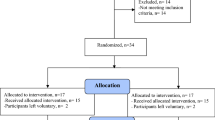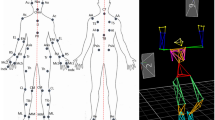Abstract
In this study, we describe the effects of a training system based on an unstable platform and a visual interactive system in improving the postural control ability. In order to verify the training effects, fifteen elderly volunteers took part in a series of balance training using this system. An additional fifteen elderly volunteers which were employed as the control group, were also tested for comparison with the training group. To evaluate the effects of the training, we measured the relevant parameters, such as the sway path and the sway area of center of pressure in the different visual conditions and standing positions, the concentric isokinetic strength of ankle and knee joints prior to and after the training. The results indicated that the training system could be used to assess successfully the gradual improvement of the postural control capability of the volunteers in the system, and showed promise in terms of improving the balance capabilities of the volunteers. Moreover, the observed significant improvement in the postural capability of the elderly subjects indicated that elderly subjects may benefit more from training using the system described herein for the improvement of postural control ability.
Similar content being viewed by others
References
Horak, F. B., Shupert, C. L. and Mirka, A., “Components of postural dyscontrol in the elderly: a review,” Neurobiology of Aging, Vol. 10, No. 10, pp. 727–738, 1989.
Laughton, C. A., Slavin, M., Katdare, K., Nolan, L., Bean, J. F., Kerrigan, D. C., Philips, E., Lipsite, L. A. and Collins, J. J., “Aging, muscle activity and balance control: physiologic changes associated with balance impairment,” Gait and Posture, Vol. 18, No. 2, pp. 101–108, 2003.
Lord, S. R., Ward, J. A., Williams, P. and Anstey, K. J., “Physiological factors associated with falls in order community-dwelling women,” Journal of the American Geriatrics Society, Vol. 42, No. 1, pp. 1110–1117, 1994.
Whipple, R. H., Wolfson, L. I. and Amerman P. M., “The relationship of knee and ankle weakness to falls in nursing home residents,” Journal of the American Geriatrics Society, Vol. 35, No. 1, pp. 329–332, 1987.
Buchner, D. M., Cress, M. E., Lateur, B. J., Esselman, P. C., Margherita, A. J. and Price, R., “The effect of strength and endurance training on gait, balance, fall risk, and health services use in community-living older adults,” J. Gerontol. Biol. Sci. Med. Sci., Vol. 52, No. 4, pp. M218–224, 1997.
Cress, M. E., Buchner, D. M., Questad, K. A., Esselman, P. C., Lateur, B. J. and Schwartz, R. S., “Exercise: effects on physical functional performance in independent older adults,” J. Gerontol. Biol. Sci. Med. Sci., Vol. 54, No. 5, pp. M242–248, 1999.
Hamman, R. G., Mekjavic, I., Mallinson, A. I. and Longride, N. S., “Training effects during repeated therapy sessions of balance training using visual feedback,” Arch. Phys. Med. Rehabil., Vol. 73, No. 8, pp. 738–744, 1992.
Piao, Y, J., Yu, M., Kim, Y. Y., Kwon, T. K. and Kim, N. G., “Development of a training system for equilibrium sense using unstable platform and force plate,” Journal of the Korean Society for Precision Engineering, Vol. 24, No. 6, pp. 121–130, 2007.
Jeka, J. J. and Lackner, J. R., “The role of haptic cues from rough and slippery surfaces in human postural control,” Exp. Brain Res., Vol. 103, No. 2, pp. 267–276, 1995.
Clapp, S. and Wing, A. M., “Light touch contribution to balance in normal bipedal stance,” Exp. Brain Res., Vol. 125, No. 4, pp. 521–524, 1999.
Lackner, J. R., Rabin, E. and DiZio, P., “Stabilization of posture by precision touch of the index finger with rigid and flexible filaments,” Exp. Brain Res., Vol. 139, No. 4, pp. 454–464, 2001.
Dickstein, R., Shupert, C. L. and Horak, F. B., “Fingertip touch improves postural stability in patients with peripheral neuropathy,” Gait Posture, Vol. 14, No. 3, pp. 238–247, 2001.
Author information
Authors and Affiliations
Corresponding author
Rights and permissions
About this article
Cite this article
Piao, YJ., Kim, K., Yu, M. et al. Analysis on training effects of postural control for elderly adults. Int. J. Precis. Eng. Manuf. 10, 133–139 (2009). https://doi.org/10.1007/s12541-009-0058-4
Received:
Accepted:
Published:
Issue Date:
DOI: https://doi.org/10.1007/s12541-009-0058-4




